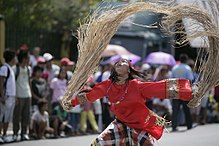 |
|
|


Filipino shamans, commonly known as babaylan (also balian or katalonan, among many other names), were shamans of the various ethnic groups of the pre-colonial Philippine islands. These shamans specialized in communicating, appeasing, or harnessing the spirits of the dead and the spirits of nature.[2] They were almost always women or feminized men (asog or bayok). They were believed to have spirit guides, by which they could contact and interact with the spirits and deities (anito or diwata) and the spirit world. Their primary role were as mediums during pag-anito séance rituals. There were also various subtypes of babaylan specializing in the arts of healing and herbalism, divination, and sorcery.[3]
- ^ Cite error: The named reference
colewas invoked but never defined (see the help page). - ^ Limos, Mario Alvaro (March 18, 2019). "The Fall of the Babaylan". Esquire. Retrieved July 12, 2019.
- ^ Scott, William Henry (1992). Looking For The Prehispanic Filipino and Other Essays in Philippine History. New Day Publishers. pp. 124–127. ISBN 978-9711005245.